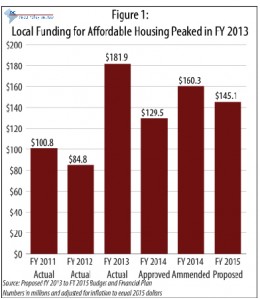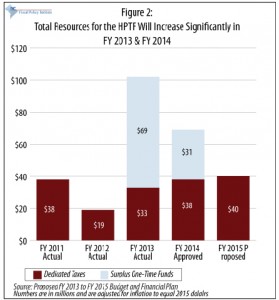Affordable housing is undeniably one of the District’s biggest challenges. So what does the fiscal year 2015 budget propose to do to address it?
The proposed budget makes a number of new investments in important housing programs, including steps to end chronic homelessness among veterans. But it also reveals serious gaps in the city’s approach to affordable housing. For example, the budget provides a one-time boost to the Housing Production Trust for a second year in a row, showing that the current taxes dedicated to the Fund are inadequate. Also, the budget would put only modest new resources into tenant-based rental assistance, even though it is the best tool for creating affordable housing quickly.
The budget proposes $145 million in local funds for a variety of affordable housing programs in FY 2015. The budget also adds $30 million in one-time funds for the Housing Production Trust Fund this year, FY 2014. When those funds are considered, the FY 2015 housing budget is lower than in both FY 2014 and FY 2013, after adjusting for inflation (see Figure 1). 
The FY 2015 proposed budget includes new funds for three housing programs:
- Local Rent Supplement Program: LRSP provides rental assistance to make homes affordable to residents with very low-incomes. The proposed budget includes $3 million for LRSP assistance tied to specific projects or to non-profit housing organizations. That will help 280 households. Another $1 million will provide rental assistance directly to about 66 seniors to help them leave a nursing home and rent a private apartment.
- Permanent Supportive Housing: The proposed budget includes $4.7 million to end chronic homelessness among veterans through the Permanent Supportive housing program. However, funding used to help other chronically homeless individuals and families would be cut.
- Housing Production Trust Fund: The proposed budget is $40 million from the tax revenues dedicated to it under a statutory formula. That is lower than in FY 2013 and FY 2014, because the mayor added one-time funds of $69 million and $31 million, respectively, in those years. (See Figure 2.)
The reliance on one-time funds highlights the limited capacity of the Housing Production Trust Fund under its current funding formula. The District should create a significant and predictable investment into the HPTF each year through regular appropriations. A goal of $100 million annually for housing production and preservation would support a healthy number of new housing units each year.

The budget also needs to go beyond its current focus on housing production. While production of new housing is absolutely needed, it can take several years before the housing is available. A quick and efficient way to create affordable housing is through rental assistance to tenants — as part of the tenant-based Local Rent Supplement Program — that pays a portion of the rent for existing housing they find on their own. But, as noted, the mayor’s budget would provide tenant-based rental assistance to just 66 new households. Increasing funds for tenant-based LRSP is an important part of addressing unmet affordable housing needs both now and in the future.
To read more about the proposed FY 2015 budget for affordable housing, visit our affordable housing budget toolkit.
To print a copy of today’s blog, click here.
